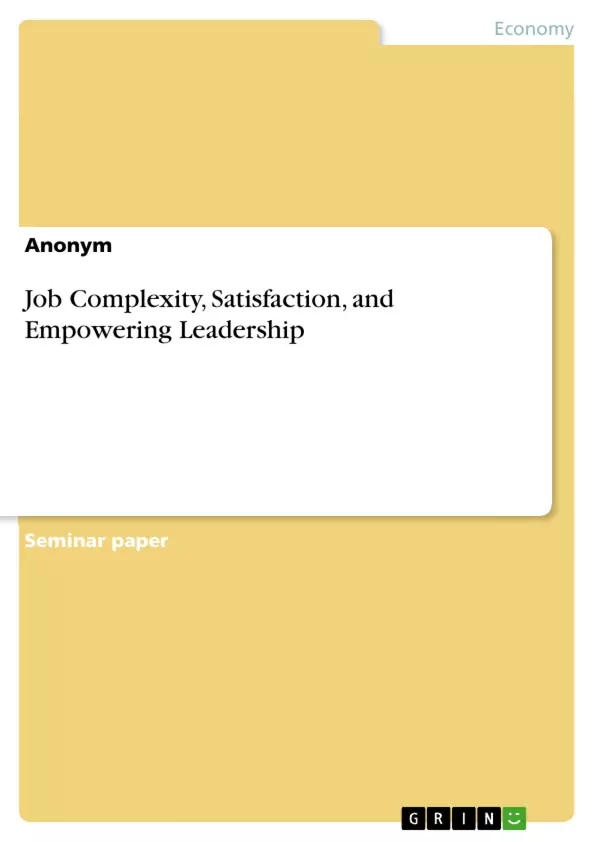This study contributes to the work design literature, investigating job complexity within the job characteristics model. In particular, the influence of job complexity on job satisfaction was statistically assessed.
Additionally, empowering leadership was analyzed as a possible moderator of this relationship. Both the main and the moderating effect were hypothesized to be positive. As it turns out, job complexity can indeed positively predict job satisfaction. However, the moderating effect of empowering leadership was found to be negative. Results are discussed in the light of previous literature, taking two possible natures of job complexity into account: that of a challenge stressor and that of a hindrance stressor.
Inhaltsverzeichnis (Table of Contents)
- Introduction
- Theoretical Foundations & Hypotheses
- Method
- Results
- Discussion
- References
- Appendix
Zielsetzung und Themenschwerpunkte (Objectives and Key Themes)
This study aims to investigate the relationship between job complexity and job satisfaction within the framework of the job characteristics model. It also explores the potential moderating role of empowering leadership on this relationship. The study hypothesizes a positive relationship between job complexity and job satisfaction, and a positive moderating effect of empowering leadership.
- Job complexity as a predictor of job satisfaction
- The job characteristics model and its application to job design
- Empowering leadership as a moderator of the job complexity-job satisfaction relationship
- The dual nature of job complexity (challenge vs. hindrance stressor)
- Implications for work design and organizational behavior
Zusammenfassung der Kapitel (Chapter Summaries)
Introduction: This chapter introduces the critical issue of job (dis)satisfaction and its far-reaching consequences, including employee turnover, poor performance, absenteeism, and mental health issues. It establishes the significance of understanding the factors influencing job satisfaction, particularly in the context of evolving work environments. The chapter highlights job complexity as a key characteristic warranting further investigation, particularly in light of the increasing prevalence of complex, high-skilled jobs in today's digitized society. While existing research has demonstrated a link between job complexity and job satisfaction, inconsistencies regarding the direction and linearity of this relationship motivate a deeper exploration, considering other potentially influential job characteristics such as autonomy.
Theoretical Foundations & Hypotheses: This chapter delves into the theoretical underpinnings of the study, focusing on the job characteristics model by Hackman & Oldham (1975, 1976). This model posits that five core job characteristics (skill variety, autonomy, task meaningfulness, task identity, and feedback) influence three critical psychological states (perceived work meaningfulness, knowledge of work outcomes, and responsibility for outcomes). These psychological states, in turn, affect employee behaviors like performance and job satisfaction. The chapter discusses job enrichment and its impact on job satisfaction, arguing that increasing job scope, or complexity, provides more opportunities for achievement and recognition, thus enhancing self-efficacy and self-esteem. Ultimately, the chapter lays the groundwork for the study's central hypothesis: a positive relationship between job complexity and job satisfaction.
Schlüsselwörter (Keywords)
Job complexity, job satisfaction, empowering leadership, job characteristics model, work design, self-efficacy, self-esteem, challenge stressor, hindrance stressor, employee motivation.
FAQ: Comprehensive Language Preview
What is the purpose of this document?
This document provides a comprehensive preview of a study investigating the relationship between job complexity and job satisfaction. It includes the table of contents, objectives and key themes, chapter summaries, and keywords.
What are the main objectives of the study?
The study aims to investigate the relationship between job complexity and job satisfaction within the framework of the job characteristics model. It also explores the moderating role of empowering leadership on this relationship, hypothesizing a positive correlation between job complexity and job satisfaction, and a positive moderating effect from empowering leadership.
What are the key themes explored in the study?
Key themes include: job complexity as a predictor of job satisfaction; the job characteristics model and its application; empowering leadership's moderating role; the dual nature of job complexity (challenge vs. hindrance stressor); and implications for work design and organizational behavior.
What is the structure of the study?
The study is structured into chapters including an introduction, theoretical foundations and hypotheses, methodology, results, discussion, references, and an appendix.
What is the focus of the introduction chapter?
The introduction establishes the significance of understanding factors influencing job satisfaction, highlighting job complexity as a key area needing further investigation, especially in today's digitized society. It mentions existing research inconsistencies regarding the relationship between job complexity and job satisfaction, motivating a deeper exploration.
What theoretical framework underpins the study?
The study is grounded in Hackman & Oldham's job characteristics model (1975, 1976), which posits that five core job characteristics influence three critical psychological states, ultimately affecting employee behaviors like performance and job satisfaction. The chapter also discusses job enrichment and its impact on job satisfaction.
What are the key hypotheses of the study?
The study hypothesizes a positive relationship between job complexity and job satisfaction, and a positive moderating effect of empowering leadership on this relationship.
What keywords describe the study's focus?
Keywords include: Job complexity, job satisfaction, empowering leadership, job characteristics model, work design, self-efficacy, self-esteem, challenge stressor, hindrance stressor, employee motivation.
What is the intended audience for this document?
This document is intended for academic use, allowing for the analysis of themes in a structured and professional manner.
- Quote paper
- Anonym (Author), 2019, Job Complexity, Satisfaction, and Empowering Leadership, Munich, GRIN Verlag, https://www.grin.com/document/591229



